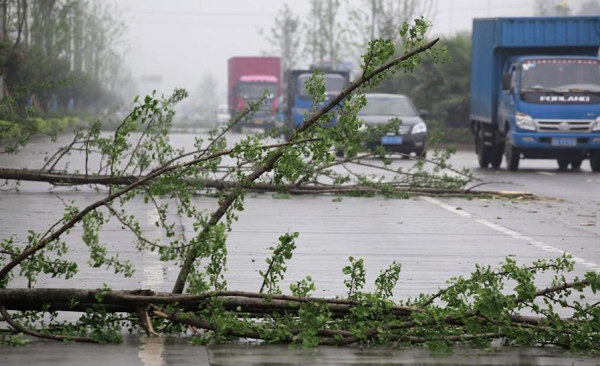Cities struggling to deal with storms
Updated: 2013-03-29 07:20
By Wang Qian (China Daily)
|
||||||||
 |
|
Trees are blown down by strong wind in Liuzhou, South China's Guangxi Zhuang autonomous region, March 28, 2013. Strong wind and thunder hit the city on Thursday. [Photo/Xinhua] |
Heavy rain, sleet, hail and tornados put drainage systems under pressure
The rising number of severe storms in China has revealed problems that are the result of rapid urbanization, experts say.
Many regions are coping with a growing number of storms that bring heavy rain, strong wind, lightning, thunder, sleet, hail, and in some cases, tornados.
These frequent and turbulent storms "are putting pressure on urban drainage systems and local authorities' emergency response systems," said Xie Yingxia, vice-president of the Institute of Urban Water and Engineering under the China Academy of Urban Planning and Design.
She said urban drainage networks have failed to keep pace with construction above ground, leading to more floods and traffic jams in cities hit by severe weather.
"In some cities, water can't flow into rivers or lakes because authorities have blocked the waterways, increasing the risk of floods," Xie said.
Li Weibiao, a professor of atmospheric sciences at Sun Yat-sen University, said studies show the Pearl River Delta is getting more heavy rainfall and afternoon precipitation.
Li said this shows a need for detailed impact studies to evaluate the associated risks and costs, and to develop strategies to cope with such events.
Since the beginning of March, South China has had five bouts of severe weather, claiming more than 30 lives, said Zheng Yongguang, a researcher at the National Climate Center's forecast office.
"Generally, we can forecast regional convective storms about 20 to 30 minutes before they happen," he said.
But Yuan Hongyong, deputy director of Tsinghua University's Center for Public Safety Research, said that is not enough time for China's emergency response system to inform people who may be affected.
"It takes at least 40 minutes for the system to work, from receiving a weather alert from the China Meteorological Administration to relaying that to the public," Yuan said, adding that a 20-minute forecast requires the system to be more efficient.
He said China's emergency response system can cover all cities through various ways, such as text messages, television, the Internet and broadcast media, but it still takes time to cover counties and villages.
The strongest tornado to hit Dongguan, Guangdong province, on March 20, showed how weak the alert system is. The tornado killed nine people and injured 272 others, causing a direct economic loss of more than 1.3 billion yuan ($209 million).
Fang Weidong, deputy director of the Dongguan emergency response office, conceded on March 22 that the system needs improvement.
The city's meteorological bureau issued alerts only for strong gales and thunderstorms before the disaster. It made no mention of a tornado.
According to the authority, the wind speed of the tornado was up to 176.8 km per hour .
Ma Xuekuan, chief forecaster at the National Meteorological Center, said the heavy rainfall will continue in South China into next week, and people should be aware of possible disasters triggered by continuous rain.
wangqian@chinadaily.com.cn

 Li Na on Time cover, makes influential 100 list
Li Na on Time cover, makes influential 100 list
 FBI releases photos of 2 Boston bombings suspects
FBI releases photos of 2 Boston bombings suspects
 World's wackiest hairstyles
World's wackiest hairstyles
 Sandstorms strike Northwest China
Sandstorms strike Northwest China
 Never-seen photos of Madonna on display
Never-seen photos of Madonna on display
 H7N9 outbreak linked to waterfowl migration
H7N9 outbreak linked to waterfowl migration
 Dozens feared dead in Texas plant blast
Dozens feared dead in Texas plant blast
 Venezuelan court rules out manual votes counting
Venezuelan court rules out manual votes counting
Most Viewed
Editor's Picks

|

|

|

|

|

|
Today's Top News
Boston bombing suspect reported cornered on boat
7.0-magnitude quake hits Sichuan
Cross-talk artist helps to spread the word
'Green' awareness levels drop in Beijing
Palace Museum spruces up
First couple on Time's list of most influential
H7N9 flu transmission studied
Trading channels 'need to broaden'
US Weekly

|

|







